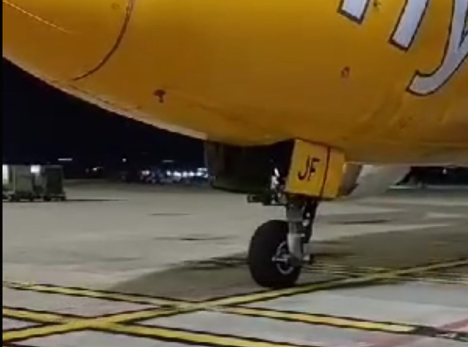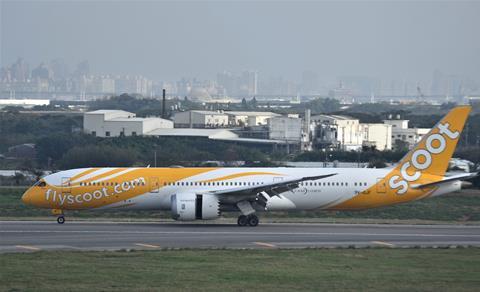Investigators have pointed to a seizure in the inboard bearing of a Scoot Boeing 787-9’s nose gear as a likely reason for detachment of its left-hand nose wheel.
Releasing the final report into the 18 June 2023 incident, the Transport Safety Investigation Bureau of Singapore (TSIB) also found that that seizure appeared to have been caused by roller skewering, though it notes the cause of the skewering could not be conclusively determined.

The incident happened as the aircraft (9V-OJF) was operating a flight from Seoul’s Incheon airport to Singapore via Taipei. The jet, carrying 343 passengers and 11 crew, was being pushed back at Incheon when ground crew felt “some resistance” while performing the pushback.
The flight crew said the aircraft’s parking brakes had been released and the aircraft carried on with its pushback. Still, they felt some vibrations as the aircraft taxied to the runway.
It was only after the aircraft approached the runway that the flight crew did not feel any vibrations, and the 787 proceeded to take off from Incheon, bound for Taipei.
As the aircraft reached the top of its climb, the flight crew conducted the standard aircraft system check, and found that the pressure readings for both nose landing gear tyres were not displayed. This could have meant the sensor was faulty, or that the nose wheel tyres had deflated.
At the same time, Incheon airport authorities found nose wheel parts – including a tyre – along one of its taxiways and suspected it could have come from the Scoot 787. The information was relayed to Taipei’s airspace controllers, who informed the Scoot crew that their aircraft might be facing a tyre issue.
Investigators note that the flight crew were prepared for a worst-case scenario in which both the nose landing gear tyres had deflated but found no guidance in their training manual on landing an aircraft with flat tyres.
After it landed at Taipei’s Taoyuan airport with no incident, ground staff found the left axle of the nose landing gear had sheared off and that the left nose wheel was missing. The TSIB found the axle face fractured and charred, an indication that it had undergone extreme heat.
After further analysis, the agency found that the inboard bearing of the left-hand nose wheel had seized, leading to the generation of high heat and the eventual fracture of the gear axle.
It notes that there was no evidence that the aircraft’s nose landing gears were over-torqued when they were installed. Adds the TSIB: “Visual bearing inspection is subjected to human factors in the inspectors’ ability to spot defects, in particular defects on the inner race surface, given the limited access. This can result in inconsistent inspection outcome.”

Following the incident, Scoot has conducted inspections of all its 787 nose wheel gears to check the nose wheel axles for signs of heat damage.
The TSIB has also urged Boeing to consider documenting information that pilots’ handling of a missing nose wheel during landing is similar to the handling of deflated wheels during landing.
According to Cirium fleets data, the aircraft (MSN37119) was delivered to the low-cost operator in August 2015, and is powered by two Rolls-Royce Trent 1000 engines.











































